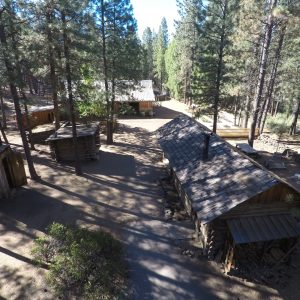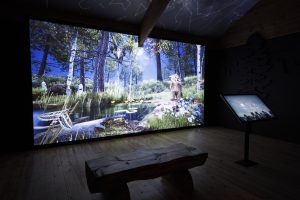Going Green Programs
The Museum sits on 135 acres of ponderosa pine forest. The large facility includes close to 100,000 square feet of roofed buildings, parking lots and roads. The Museum has dedicated its efforts to “going green” in its day-to-day operations, its energy usage and energy efficiency, and its carbon footprint.
From solar power to dark-sky friendly outdoor lights to the Museum’s property-wide recycling program, “going green” is more than just a catchphrase.

Conservation in action
With thousands of visitors a year, the Museum has been dedicated to green practices almost since its founding. In 1994, the High Desert Museum became the first commercial building in Oregon to install solar power. The efforts didn’t stop there, either. Green practices include:
- Partnering with the Energy Trust of Oregon and annually hiring an intern who evaluates the Museum and identifies areas of energy-intensive use.
- Indoor motion-detection lights to reduce energy consumption.
- Maintaining a property-wide recycling program.
- Installing dark-sky friendly outdoor light fixtures to reduce light pollution.
- Providing reusable cutlery, plates, bowls and glasses at the Rimrock Cafe.
The result? The Museum provides a positive example to the community on green practices.
 To measure growing light pollution in the area, the Museum mounted a Sky-Quality Meter on its property. The meter collects light pollution data, which the Museum sends to DarkSky Oregon, a conservation organization that tracks and shares light pollution data.
To measure growing light pollution in the area, the Museum mounted a Sky-Quality Meter on its property. The meter collects light pollution data, which the Museum sends to DarkSky Oregon, a conservation organization that tracks and shares light pollution data.
The result? With its Sky-Quality Meter, the Museum provides quarterly data to DarkSky Oregon. Research into light pollution has led to a larger dark-sky conversation initiative including an exhibit, an interactive experience, a grant, and multiple public programs.
 In June 2024, the Museum opened Forest at Night, an interactive experience in which visitors encounter more than 35 nocturnal animal and plant species with a touch of their fingers. Visitors learn about the importance of dark-sky habitats and the growing impact of light pollution. The interactive exhibition also includes education about SAFE species, including migrating songbirds such as the Townsend warbler.
In June 2024, the Museum opened Forest at Night, an interactive experience in which visitors encounter more than 35 nocturnal animal and plant species with a touch of their fingers. Visitors learn about the importance of dark-sky habitats and the growing impact of light pollution. The interactive exhibition also includes education about SAFE species, including migrating songbirds such as the Townsend warbler.
The result? More than 216,000 visitors a year have access to education about nocturnal species. Visitors are encouraged to analyze their own homes to reduce light pollution, including turning off lights at night, using timers and dimmers and choosing warm light bulbs that are 2,700 kelvins or less.
